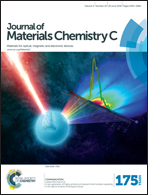Osmium-nitrido corroles as NIR indicators for oxygen sensors and triplet sensitizers for organic upconversion and singlet oxygen generation†
Abstract
The photophysical properties of nitridoosmium(VI) corroles have been investigated. The complexes exhibit room temperature NIR phosphorescence (λmax 779–795 nm). Long decay times (110–150 μs in solution and 136–183 μs in polystyrene) are responsible for efficient quenching of the emission by oxygen. All the complexes act as efficient sensitizers of singlet oxygen (quantum yields of 1O2 0.76–0.95). Optical oxygen sensors prepared on the basis of nitridoosmium(VI) corroles exhibit high photostability and excellent sensitivity in the physiologically relevant range. The complexes have also been found to be promising sensitizers in triplet–triplet annihilation-based upconversion systems. Finally and not least, simple synthetic accessibility makes these dyes particularly attractive for application as optical materials.


 Please wait while we load your content...
Please wait while we load your content...